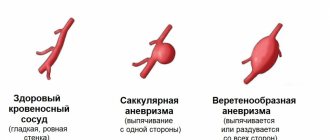What are training contractions?
As you can easily guess from the name, they are not real. These uterine contractions are not aimed at starting the labor process. Usually they are irregular, rare and do not cause significant pain.
This phenomenon has other names. Sometimes they are called even more obviously - false, as opposed to true labor pains. In the specialized literature you can find the term “Braxton-Hicks contractions” after the name of the English obstetrician-gynecologist who first drew attention to them and described them.
When to go to the maternity hospital?
In some women who are late in pregnancy ( around 40 weeks
), false contractions may appear and quite strong ones at that.
They gradually acquire normal intensity and regularity and last longer. This phenomenon may well be a sign of approaching labor and the transition of false contractions to real ones.
In such a situation, you should not be embarrassed and it is better to immediately go to the hospital for preservation.
There are a number of symptoms that indicate the beginning of the process. These include:
- discharge with bloody impurities (occurs when the placenta separates);
- water is released (a sign of gradual release of water);
- discharge of dense mucus (discharge of mucus plug);
- the pain moved to the lower back and tailbone;
- the child ceases to be active, he does not kick or move;
- contractions are repeated about 4 times per minute;
- there is a discomfort of a pressing nature on the perineal area.
In later weeks, as the nature of contractions progresses, it is worth starting to note the frequency between them and duration. You should definitely share your condition with your obstetrician-gynecologist. The more detailed a woman in labor can explain her condition, the greater the chance of identifying any possible pathologies.
Why do they happen?
Medicine does not have an exact answer to this question. There is not even a consensus on whether they are part of the normal pregnancy process or a deviation from it. Most experts adhere to the first version, considering them to be a warm-up for the body before real childbirth.
It is assumed that false contractions are needed to maintain the tone of the uterus - it, like any other muscular organ, requires periodic exercise. On the other hand, the time of arrival and frequency of training contractions vary greatly among different women, and some mothers who have successfully given birth are not at all familiar with these sensations.
Indicators of pregnancy pathology
In some cases, pain in the lower abdomen may be a sign of problems in the healthy course of pregnancy. They require immediate medical attention.
1. Temperature. An increase in body temperature against the background of painful muscle contractions of the uterus may indicate the development of an intrauterine infection. In this case, inflammation of the membranes or placenta occurs. When diagnosed, the pregnant woman also has polyhydramnios, and the fetus has tachycardia. The inflammatory process is a dangerous complication. According to statistics, 90% of cases of late miscarriages and premature births are associated with infectious diseases. Therefore, if the body temperature rises, a woman should consult a doctor as soon as possible.
2. Severe pain. Training contractions are not characterized by significant pain, and if the pain is intense, this may indicate placental abruption even in the absence of bleeding. With central detachment, a hematoma can form in the woman’s body, between the wall of the uterus and the placenta. This condition threatens the life of the mother and child, and therefore requires immediate hospitalization of the pregnant woman.
3. Frequent occurrence. If false contractions occur more often than four times per hour and more than six times during the day, this may be a sign of premature labor. Only timely medical assistance can stop them, so you need to see a doctor as soon as possible.
If these conditions are detected, you should call your doctor and tell them how you feel. The doctor will recommend further tactics of action. If you can’t get through to the doctor, you need to call an ambulance or go to the maternity hospital yourself.
pixabay.com/
How long do training contractions last?
Contractions last several seconds, rarely up to 1 minute, and end as suddenly as they come. Then the expectant mother begins to listen to her feelings and wait for new ones, but they do not repeat themselves. When the woman has completely calmed down, contractions may return after a considerable time - 4-5 hours.
After several unexpected cases, false contractions become familiar, and the expectant mother ceases to be afraid of them. However, in the last weeks until hour X, they may surprise you again - often training contractions before childbirth become longer and more intense.
How do you feel during training contractions?
False contractions are not painful, but, unfortunately, if this is your first pregnancy, you have nothing to compare with. But there is another sure sign: all the muscles of the uterus are involved in labor contractions, and during training pain sensations are localized only in one area.
Frequency and localization of training contractions of the second and early third trimester, precursor contractions, labor contractions. Example.
False contractions usually appear as muscle spasms in the back, front, or top of the uterus. The intervals between them are irregular, and it is impossible to predict where the attack will move next time. A few weeks before giving birth, training contractions, which are now called precursor contractions, will become more frequent, but will retain their character - an attack localized in one area of the uterus. During labor contractions, all the muscles of the uterus contract simultaneously.
Pain relief during childbirth
Any woman has the right to receive the necessary pain relief during childbirth - non-pharmacological (psychological preparation, acupuncture, massage) and medicinal (drug administration).
Indications for labor anesthesia are: a feeling of severe, unbearable pain, signs of autonomic imbalance (sweating, tachycardia, hypertension, redness of the skin), restless behavior of a woman, fatigue, exhaustion, pathological course of pregnancy and childbirth.
Epidural anesthesia is the most effective method, it is used quite widely, it is carried out by an anesthesiologist, installing a catheter in the epidural space at the lumbar level and injecting an anesthetic drug into it.
Contraindications are refusal of the woman in labor, bleeding or its risk due to taking anticoagulants, infection in the injection area. The advantages of this method are the high efficiency of pain relief while maintaining the woman’s consciousness, without suppressing labor and affecting the condition of the mother and fetus. Disadvantages are the risk of complications in the form of pain at the injection site, decreased blood pressure, and headache may occur.
In addition to medication, positive anticipation, distraction, meditation, psychotherapy are important, including long before childbirth, at the preparation stage, and during prenatal courses for expectant mothers. This will help reduce the psychogenic component of pain and ease the course of labor. Indications for labor anesthesia are: a feeling of severe, unbearable pain, signs of autonomic imbalance (sweating, tachycardia, hypertension, redness of the skin), restless behavior of a woman, fatigue, exhaustion, pathological course of pregnancy and childbirth.
Are training contractions dangerous?
There is no evidence that training contractions have any effect on fetal development. Their only danger is psychological. Some women, feeling unexpected contractions of the uterus, panic, and in this state they can do stupid things.
Remember that the onset of any contractions, even labor, does not mean that you will give birth in the next few minutes. There is time, so you need to calm down, take a deep breath and listen to your feelings. If you can't tell whether these are practice contractions or real contractions, call your doctor and describe your symptoms. After listening to your answers, he will tell you what to do - go to the maternity hospital or stay at home.
How to distinguish training contractions from contractions before childbirth?
Expectant mothers can almost accurately identify training contractions during their second and subsequent pregnancies. While you do not have experience yet, we recommend paying attention to the following signs:
- Training contractions are rarely painful, rather unexpected. The same cannot be said about childbirth - many women compare these sensations with very severe pain during menstruation.
- Training contractions can usually be stopped. Leisurely walking around the room, breathing exercises and other calming exercises can completely eliminate discomfort in the uterine area.
- They are not regular and have no obvious dynamics. In real contractions, on the contrary, there is regularity, a gradual increase in duration and a decrease in the interval between them.
For simplicity, we have collected the distinguishing features of false and true contractions in a table:
Is it possible to calculate training contractions somehow easier?
It just won't work. You will still have to listen to your feelings and record them. But you can get yourself an assistant - a special mobile application for calculating the duration and intervals between contractions. All such applications work intuitively - you just need to press a large button every time an attack begins or ends.
Mumlife contraction counter.
In addition to recording and visualizing contractions, the application has useful additional functions. It tracks the dynamics of the seizures and will tell you if it is similar to labor. And it will even show how much time you have left to get to the maternity hospital.
What to do?
You don’t have to do anything - after a while, the training contractions will go away on their own. However, there are several proven methods that help reduce discomfort during false contractions and make them disappear quickly. Here are some of them:
- Walk around the house.
Calm, slow walking in most cases allows you to get rid of unexpected uterine contractions. If the weather is good outside and there is a suitable place for exercise nearby, you can also take a breath of fresh air - this will not be a bad thing.
- Lie down and relax.
If you're not in the mood for a walk right now, lie down on the sofa or bed, find a comfortable position and think about something positive. It has been noticed that the best results are obtained by lying on your left side.
- Take a bath or shower.
Water relaxes, and during training contractions this is just what you need. Fill the bathtub with water or stand in the shower and wait for the contractions to end there - most likely, this will happen very soon. But remember: only warm water, no hot baths or contrast showers!
- Drink some water.
Dehydration can cause muscle spasms, so it is also considered a factor in causing false contractions. Pour a glass of water and drink it slowly, alternating sips, inhalations and exhalations. Water can be replaced with some other drink, but only healthy, for example, berry juice or rosehip decoction.
- Do breathing exercises.
Proper breathing techniques are useful not only during training contractions. Before childbirth, they help to calm down, during childbirth - to relieve pain and better control your body. While the body is training the uterus, you train your breathing.
- Go to the toilet.
A full bladder is considered one of the culprits of false contractions: it puts pressure on the uterus, provoking its contractions. So before you settle into bed or go for a walk, don't forget to visit the toilet.
- Walk around the house.
Calm, slow walking in most cases allows you to get rid of unexpected uterine contractions. If the weather is good outside and there is a suitable place for exercise nearby, you can also take a breath of fresh air - this will not be a bad thing.
- Go to the toilet.
A full bladder is considered one of the culprits of false contractions: it puts pressure on the uterus, provoking its contractions. So before you settle into bed or go for a walk, don't forget to visit the toilet.
Symptomatic picture
What is a fight? With it, all the muscles that envelop the abdomen contract. These are the muscles of the abdominal region, lateral, back, uterine, muscles in the small and large pelvis. During the period of contraction, a large amount of lactic acid is supplied to them, which is why the contraction is much more intense than usual (as when playing sports, for example). This general pressure pushes the child out.
The mechanism of occurrence of Braxton-Higgis and real contractions is very similar. With false contractions, not all muscle groups may be involved. Labor does not begin due to the lack of a signal from the woman’s hormonal system.
False contractions have basic characteristics. These include:
- duration
: in most situations about 30 seconds (no longer), in very rare cases it is 2 minutes; - frequency
: in 95% of contractions per hour, contractions are repeated less than 4 times, no more; - nature of the sensations
: there is no particular pain, but the petrification of the abdomen is visible and palpable.
With false contractions, just like with real ones, unpleasant sensations arise. During Braxton-Higgis contractions, the woman in labor feels:
- Pain
. The peculiarity is that it is not so much pain as discomfort. - Discomfort
. It concentrates at one point and does not have a surrounding character. - Feeling
that the uterus has shrunk.
All these feelings arise very chaotically and unpredictably. There is no system or regularity. Such contractions go away on their own and do not require any anesthesia or other medication.
It happens that during the petrification of the abdomen, a woman can even see what the position of the child is inside.
What can cause Braxton-Higgs contractions?
False contractions can be caused by a number of reasons. This is due to the fact that during pregnancy, mother and child are one and everything that happens to her stimulates the baby too. Matchmaking may occur due to:
- excessive activity of the expectant mother (for example, excessive physical activity) or the child himself moves a lot in the womb;
- psycho-emotional stress in a woman in labor (that’s why they say that pregnant women should not worry or worry);
- dehydration;
- lots of sex or intense orgasms;
- bladder overflow.
This type of contraction can even occur due to a hand placed on the stomach and other minor impacts. This does not mean that you should not touch your stomach at all, but it is better to avoid the points listed above.
[media=
https://youtu.be/8nG_CpKSCkE
]







